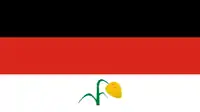Kunama people
The Kunama are an ethnic group native to Eritrea. Although they are one of the smallest populations in Eritrea, constituting only 2% of the population, 80% of Kunama live in the country. Most of the estimated 260,000 Kunama live in the remote and isolated area between the Gash and Setit rivers near the border with Ethiopia. The Kunama people have ancient ancestry in the land of Eritea [4] The Ethiopian-Eritrean War (1998–2000) forced some 4,000 Kunama to flee their homes to Ethiopia. As refugees they reside in the tense area just over the border with Eritrea and in proximity to the contested border village of Badme.[5] In the 2007 Ethiopian census, however, the number of Kunama in Tigray has dropped to 2,976 as the remaining 2,000 or so members of this ethnic group have migrated into the other Regions of Ethiopia.[6][7][8]
 Flag of the Kunama people democracy | |
| Total population | |
|---|---|
| 260,200[1] | |
| Regions with significant populations | |
| indigenous to | |
| Languages | |
| Kunama | |
| Religion | |
| Christianity (Eritrean Orthodox Tewahedo Church, Eritrean Catholic Church, P'ent'ay), Islam[3] |
Demographics
The Kunama speak the Kunama language. It belongs to the Nilo-Saharan family, and is closely related to the Nara language. Although some Kunama still practice traditional beliefs, most have adopted Christianity and Islam. The fertile plains of the Gash-Setit, also known as the Gash-Barka, region where the Kunama live are sometimes referred to as the "breadbasket of Eritrea". Formerly nomadic, today they are farmers and pastoralists. Historically, the Kunama have been dominated by other ethnic groups and they are often forced from their traditional lands. The official policy of the Government of Eritrea is that all land is state property and the Government encourages large commercial farms.[9] The Kunamas are settled agriculturalists and pastoralists living mainly from cattle. They are matriarchal with a prominent role played by women. According to their social system, a child is a member of Kunama society only if his or her mother is Kunama, and relatives are only recognized on the mother's side.[10] The Kunamas are both lingustically and culturally closely related to the Nara people of Eritrea.[11][12]
Media
The award-winning documentary film Home Across Lands[13] follows a group of Kunama refugees resettled in the United States and their attempts to adapt to life in their new home.
References
- https://www.worldatlas.com/articles/who-are-the-kunama-people.html
- Central Statistical Agency (2008), "TABEL 5: POPULATION SIZE OF REGIONS BY NATIONS/NATIONALITIES (ETHNIC GROUP) AND PLACE OF RESIDENCE: 2007", Census 2007 (PDF), Addis Ababa: Central Statistical Agency, p. 66 Unknown parameter
|archive- url=ignored (help) - Project, Joshua. "Kunama in Eritrea".
- https://study.com/academy/lesson/eritrean-ethnic-groups.html
- "Forgotten People: The Kunama of Eritrea and Ethiopia". Archived from the original on 2007-12-18.CS1 maint: bot: original URL status unknown (link)
- Census 2007, Table 5
- https://www.refworld.org/docid/3f520a484.html
- https://minorityrights.org/minorities/kunama-and-nara/
- Naty, Alexander. "Memories of the Kunama of Eritrea towards Italian colonialism." Africa: Rivista trimestrale di studi e documentazione dell’Istituto italiano per l’Africa e l’Oriente 56.4 (2001): 573-589.
- https://www.refworld.org/docid/3f520a484.html
- https://www.tandfonline.com/doi/abs/10.1080/03014467400000421?journalCode=iahb20
- Excoffier, Laurent; et al. (1987). "Genetics and history of sub-Saharan Africa". American Journal of Physical Anthropology. 30: 151–194. doi:10.1002/ajpa.1330300510. Retrieved 1 September 2016.
- "Home Across Lands". 2012-03-03. Retrieved 2018-04-13.